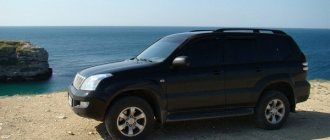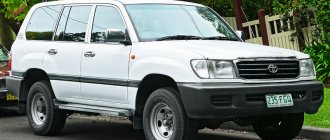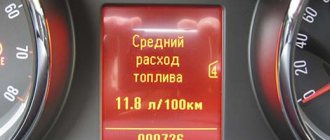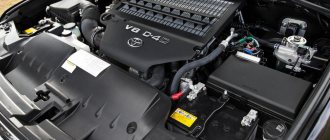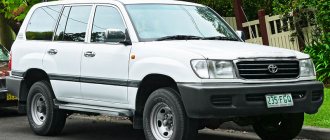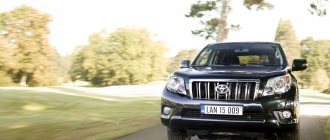This article will talk about a unique SUV from a Japanese manufacturer. Land Cruiser 100 is still considered the largest off-road vehicle from Toyota. Production began in 1998. The 100th model replaced the 80th.
Huge headlights, large fenders, and the power that is hidden under the hood seem to have a hypnotic effect on those who love big cars. “Sotka” is popular among law enforcement and security officers, large business owners, and bankers.
History of appearance
The first Land Cruiser appeared in 1953. The hundredth model became the seventh in the lineup of SUVs in this series.
The car was first presented in 1997 in Tokyo. The car went on sale the following year. Compared to the 80th model, the Land Cruiser 100 has a more modern appearance. Driving on the updated Cruiser has become more comfortable.
In 2003, the “weaving” was slightly redesigned. The car received new bumpers, optics and interior trim. But this modification was available only to consumers on the American market.
These machines are distinguished by their reliability and high maneuverability. That is why the newly released models were purchased by the UN. A separate model was also released for the domestic Japanese market. It was called Land Cruiser Cygnus. The Japanese sold a more prestigious car. It featured a luxurious interior, as well as options that are an attribute of luxury cars. A little later, a representative of this line will appear in Russian car dealerships under the Lexus LX470 brand.
What else do owners note?
Only during the operation of the car can all its advantages and disadvantages be revealed, so it would be useful to know a few more nuances that the owners talk about.
Often Toyota Land Cruiser 100 reviews indicate insufficient anti-corrosion treatment in places that are hidden from everyday inspection, for example, under the lights, on the inner surfaces of the doors. After some time, traces of rust appear there. To avoid this, you have to spend additional money on good anti-corrosion protection.
The problem of quality fuel is equally acute for both diesel engines and gasoline units. On diesel engines, the first thing that gets clogged is injectors and filters. It is almost impossible to repair it yourself due to the complexity of the fuel system; you need to take it to a service center. The cost of replacing injectors can be 60 thousand rubles. In addition, high sulfur content has a bad effect on motor oil, as a result of which it loses its cleaning properties. Gasoline units become less responsive and consumption increases.
With large differences in opinion about the reliability of a particular unit, everyone notices that the weak point of the car, especially in conditions of bad Russian roads, is the lower arm of the front suspension. It would not hurt the manufacturer to increase the resource of this unit. In addition, the steering rack can also be called a problem area.
The prices for spare parts are good. Compared to other cars in this class, the Sotka is somewhat more affordable. So, for the 2006 model, the cost of the original wing is, according to average estimates, about 12 thousand rubles, the cost of the bumper is 5 thousand. Naturally, for some sedan such a price category would be an unbearable burden, but its capabilities are completely different.
Modifications
The SUV was produced only in a 5-door configuration. And the Japanese manufacturer’s competitors produced short and sometimes even open versions of the bodies. The car is based on a very powerful spar frame. The body is very powerful and galvanized on both sides. You can verify this by looking at the design of the Land Cruiser 100 SUV (photo can be seen below).
"Sotka" was produced in various modifications. The cheapest ones are GX and STD. They are distinguished by unpainted bumpers and a hinged rear door. The STD version does not provide electrical seat adjustment, mirror adjustment and steering column adjustment. This version lacks ABS and many other options. The interior is trimmed with cheap leatherette.
The GX version looks richer. There is an electrical package, the interior is trimmed with velor, and roof rails are installed. This version can accommodate more than 10 people. For this purpose, there are folding seats at the rear. In addition, there were GX with 9 seats.
The VX version is considered luxury. It was supplied in versions for 5 and 7 seats. The car has excellent sound insulation. The options and equipment here are much more functional and more expensive. The interior is trimmed in leather, has climate control, standard xenon, and stability control system.
Here you can find Arabic versions of “Cruisers”. Among the mass of similar Toyotas, they can be distinguished by their golden nameplate and air conditioning. As for service, everything here is the same as with European models. Reliability at a high level.
HBO on Cruiser: danger or necessity
Some Toyota Prado owners do not dare to modify their car, fearing the explosive characteristics of gas. A correctly installed gas equipment completely eliminates the possibility of methane leakage, therefore it is safe to use. The advantages of installing the unit include:
- Low gas consumption for Toyota Land Cruiser 100.
- Slow combustion. This reduces wear on piston parts and crankshaft. As a result, the motor runs smoothly.
- Good diffusion. The cylinders are gradually filled with methane. There is no carbon deposits on the pistons, valves and spark plugs.
- Anti-knock characteristics. Methane has an octane number in the range of 103-105, which eliminates the possibility of a gas explosion and fire of structural elements of the power unit. This is especially true for engines with a significant level of compression.
- No corrosion catalysts. The gaseous composition does not include chemical elements such as lead and sulfur, which cause destruction of the internal surface of the combustion chamber and parts of the catalytic converter.
- Stable state of aggregation. Methane is supplied to the power plant in the vapor phase, without washing off the oil film from its surface and without mixing with the lubricant in the crankcase.
Reviews from car owners characterize gas for the Land Cruiser 100 on the positive side, noting an extension of the life of the power plant by 30-40% compared to units running on gasoline. The engine wears out twice as fast, and the lubricant needs to be changed less frequently.
Body
“Sotka” is not a model name, but rather a name for the body. It was borrowed from the Lexus RX 300 SUV. In principle, the cars in the standard configuration and the GX variants are still the same 80th model, only on a new body. They are bought by those who want to own a large SUV and save money.
In general, the body is almost problem-free. It is double-sided galvanized, which means it is reliably protected from corrosion. Toyota Land Cruiser 100 fenders reliably protect fog lights from stones and dirt. Electrical equipment, of which there is a lot in the car, works properly. There is a sense of quality in everything.
Salon
Here, too, everything is almost perfect. It will be comfortable for both short and tall people to sit in the driver's seat. As soon as the driver takes the key out of the ignition, the steering wheel moves back and does not interfere with comfortable entry or exit. In addition, the position of the steering column can also be further adjusted with a button. The range of settings is enough for everyone. Apart from the steering wheel, you can adjust anything here, of course, depending on the configuration. For example, you can customize the chair, mirrors and much more. In general, the interior of the Land Cruiser 100 will suit a car enthusiast of any size.
To make driving these cars comfortable, the comfort-loving Japanese equip the models with air conditioning and climate control. This is true perfection. The passenger or driver can set the desired temperature in different zones and adjust it at their discretion, and if you are tired of using electronics, then you can open the hatch. Let's move on to the question of the “heart” of the Land Cruiser 100.
Review of Toyota Land Cruiser 100 4.2 TDi (2006)
I purchased the LC 100 new in March 2007. at the official's dealer, VX R1 equipment (manual transmission, velor, 10 seats, category D) 204 hp turbodiesel. I came across this modification by accident (they say it was produced only last year, instead of 105) new for 1.4 million rubles. Unlike the R2, there is no sunroof, leather, electric seats, or radio. After a 10-minute examination, I realized I had to take it.
You won’t find a better price-quality-equipment ratio for an SUV of this class. Additionally, I installed a radio, signaling system, manual transmission lock, and insured it (total: 1.5 million rubles). I changed category D to B by throwing out the rear benches and making changes to the design of the car, it took two days of running around the traffic police. (although people have been driving 105s for 10 years without changing the category, not in PTS, not licensed) You can hit the road!
Exploitation. Mileage 22 thousand km. (previous cars VAZ, CRV, LC80, Vitara, RX300) has been driving for 15 years, not a newbie. City: Consumption from 13 to 17 liters. diesel fuel, depends on the rhythm and driving style. A slight discomfort immediately emerged - the first gear is short, before you have time to get underway, it’s time to put in the second. But this is probably the only drawback for me. Despite this, the acceleration is acceptable (13.6 s to a hundred) and you don’t feel inferior in traffic. But what a pickup the turbo diesel has in the middle (3-4-5 are very long!) gears, it pulls from 1300 rpm, once again there is no need to shift. The seating position is high, you look above the traffic and have time to react to changes in the situation.
The attitude of other drivers is respectful; in 8 cases out of 10, they let you through as soon as you turn on the turn signal. By the way, this also inspired me to be more helpful and polite on the road. High ground clearance solved all parking problems - in winter on an unoccupied snowdrift, in summer - on a curb (if there are no spaces). It doesn’t care at all about the road surface and rails - just a slight rocking and shaking on large potholes, and no worries about the condition of the suspension.
Track: Everything is good here on straight sections. It doesn’t prowl, it doesn’t crack, everything is smooth and dignified. 5th gear easily pulls from 80 to 170 km/h. The pickup when overtaking is decent, there is almost always a reserve of traction. Constant full instills a certain confidence when passing heterogeneous sections of the road surface. But a heavy SUV and its frame structure (as a result of a high center of gravity) requires braking and careful cornering (not a sports car), but at a calm pace of 100-110 km per hour, braking up to 80-90 km per hour is not annoying.
Consumption in this mode is 9-10 liters. per 100 km. I drove 500 km once on a cruise (set to 99 km/h), so the consumption was 8.5 liters. If you drive 140-160 (I rarely drive like this, without children, on an empty highway) then 12-14 hp. but not more. In winter, snow-covered roads do not bother you at all; it holds the road confidently (large weight, all-wheel drive, good winter tires).
Off-road: I constantly go fishing, and I try to turn the road into a small trophy raid. I'm not looking for easy ways. The cross-country ability is excellent. The approach and departure angles, the ground clearance (excellent geometric cross-country ability) allow you to safely storm gullies, hills, ruts, ravines, I’ve never hit you (although on the LC80 I didn’t notice a stump and dented the threshold there), but now I have some experience and I’m helping the car head.
Dirt and slurry passed along the door (that’s where the first short one came in handy) and was blocked only by the interwheel confidently crawling. In general, if you don’t put it on your belly, it’s not pure road tires and your head will only get stuck where others won’t even get there. For full sensations, I accelerated to 80-90 on a freshly mown field. In winter I rode in the snow, somewhere up to the hub, a little higher than the snow - only positive emotions.
Inside: The salon is large and spacious. My height is 185 cm, it was not difficult to find a suitable position for me, and there is enough space behind me. Everything is at hand, power windows on all cars, electric mirrors on the doors, folding buttons (useful when squeezing through the forest among the birch trees). Convenient route computer (consumption, balance, speed, etc.), only its switch button is not backlit.
Climate, rear heater, heated mirrors - everything you need and nothing extra. I threw out the standard acoustics and installed DLS. What else is needed is heated seats (although not leather, throwing the sheepskin seems to help). The trunk is huge, the second row folds 60 to 40. I don’t need a tent; I sleep in the car, diagonally, at full height. A wonderful tailgate on which three of you can sit and dangle your legs (it’s convenient to sit down and change your boots, just have a smoke break, and even set up a table).
It’s too early to talk about reliability, for the LC 100 this is not a mileage, so far everything is fine, nothing has fallen off or broken. This engine has been produced in a naturally aspirated version for 30 years, and in principle it eats up any diesel fuel. It is one of the first diesel engines certified for Russia. It started easily the first time at -32 without any webast. But I try to refuel at proven gas stations, on the bank of an expensive high-pressure fuel pump. I installed a turbo timer to save the turbine. In principle, these are two difficult places in the engine, the rest is said to be super reliable. A friend of mine has one of these from 1998 (4.2 automatic transmission) and has done 430 thousand km; he only changed the fuel injection pump.
Now about the patient: The service is expensive, long, tedious and pointless. Interservice mileage is 10 thousand km. It’s normal for a diesel engine, but the price tag for work and spare parts from the officials is simply exorbitant - three prices compared to an ordinary one. There is a queue for maintenance, in order to wash it completely you have to persuade him to accept one, do another, give away a third - in the end you won’t find anyone to blame. The narrow specialization of individual craftsmen working every other day forces them to go through nonsense two or three times (setting up - coordinating the alarm for the operation of the turbo timer). Only the guarantee holds. Maintenance 10,000: oil and filter change - 9,000 rubles. Maintenance 20,000: oil change, filters, pads, handbrake tightened - 17,000 rubles.
It seems like everything I wanted to tell the main thing. Thank you for reading. Conclusion: the car is decent, reliable, unpretentious, versatile, masculine: for all occasions of active life.
Engine
Since there are several trim levels of the car, there are also several power units.
The diesel engine is based on previous models. It is equipped with a turbocharger and an air cooler, as well as an electronic injection timing control system. This increased power and torque. The car began to accelerate better. Toyota now does 100 km/h in 13 seconds. Also, with the new engine, diesel consumption per liter has decreased. The power unit managed to surpass the gasoline engine that was installed on the 80s Cruiser models.
Diesel SUVs were imported through “gray” suppliers. There were regularly problems with them, since the Land Cruiser 100 had engine specifications that required a different quality of diesel fuel. Due to the “high quality” of local fuel, fuel injection pumps and injectors especially suffered. But diesel was much more economical. Here the consumption was only 16 liters per 100 km. It is known that until 2002, Land Cruisers were equipped with another diesel engine. The unit was much more powerful than the others, but in Russia it is very rare, just like a regular turbodiesel.
“Sotki”, which were sold by official dealers, were equipped with a V8 gasoline engine. Most of the cars had a 235-horsepower unit with the VX modification under the hood. It had a smooth and very quiet ride, and the car had excellent dynamics. The engine allowed it to accelerate to 100 km in 11.7 seconds. This is a good indicator for a car weighing 2.5 tons. The only disadvantage of this engine is its high consumption: the Land Cruiser 100 “eats” from 18 to 25 l/100 km.
There is also a naturally aspirated diesel engine. It is installed on STD and GX. This is a 6-cylinder engine with a capacity of 130 hp. With. It is not equipped with a turbine, so it is a bit phlegmatic.
Whatever the engine in the “hundred”, they are all quite reliable. The owner only needs to undergo regular scheduled maintenance.
Reviews of Land Cruiser
Consider several real reviews about this car.
- The car is good, excellent handling, it is used in northern conditions, the turbodiesel has not yet failed. Fuel consumption is very low for its class. It is trouble-free on long trips both in summer and winter. Victor Belov, 2001.
- The car is great. I consider the design, reliability, and fuel consumption for such an engine with such a vehicle weight and 4-wheel drive to be absolutely excellent! I've been driving for a year and a half, and I like it more and more. Alexey Suvorov, 2000.
- The dynamics are lacking, but the fuel consumption is pleasing, now 11.1 liters per hundred. Crickets appeared in the cabin, but otherwise there were no problems. Oleg Kabanovsky, 2008.
Transmission
The choice of gearbox is available only to those who purchased a VX with a turbodiesel. Here the manufacturer provides both automatic and manual. Only the automatic transmission works with the VX petrol unit. The standard and GX versions are mechanically friendly. Car owners claim that both automatic and manual are equally reliable.
All modifications and versions have all-wheel drive, as well as forced differential locking.
Land Cruiser costs on gas compared to gasoline
Averaged data proves the financial benefits of installing gas equipment using methane. The savings are approximately 15-20%. However, they do not take into account the following factors influencing this indicator:
- congestion on city highways;
- acceleration dynamics;
- ambient temperature;
- engine's type.
But these statistics give a general idea of the financial advantages of gas equipment.
If the car is used infrequently and for short trips, the difference will not be so noticeable. It makes sense to replace a gasoline engine with gas-cylinder equipment only when the vehicle is used intensively. Methane consumption on the Prado is 13 liters per 100 km when driving on the highway.
For comparison, we can cite the standard use of a car with a 4.5 MT power plant and a 96-liter fuel tank. A Land Cruiser running on methane will cover 895 km on city streets without refueling, and 1,508 km on the highway. In the combined cycle, the fuel is enough for 1208 km. Under similar conditions, a car with a gasoline unit will travel:
- in the city – 495 km;
- along the highway – 722 km;
- in combined mode – 578 km.
The price of gas is lower than the cost of gasoline, so methane on Kruzak significantly reduces the cost of maintaining and operating the car.
Specifications
The curb weight of the car is 2650 kg, and the total weight is 3260 kg. The maximum speed is 175 km/h. Fuel tank volume – 96 l. The length of the Cruiser is 4890 mm, width is 1940 mm, and height is 1880 mm. Wheelbase – 2850 mm. The transmission is presented in the form of all-wheel drive with a locked differential. Transmission – 5-speed manual or 4-speed automatic. The brakes are equipped with a vacuum booster. The steering system is made on the basis of a steering rack. Ground clearance is 220 mm.
Such basic technical characteristics and relatively low fuel consumption allowed the Cruiser to truly be the best in its class. The unique suspension allows you to drive almost anywhere under any conditions.
Fuel consumption
The most important issue that worries every car owner when operating a car is probably fuel consumption.
To begin with, we note that the Toyota Land Cruiser 100 is offered with two engine options: gasoline and diesel. According to the manufacturer, the 4.7-liter gasoline unit is distinguished by high technical characteristics and dynamism. In their opinion, the second diesel engine with a volume of 4.2 liters is still considered more reliable and economical.
As you know, the issue of consumption must be approached based on the engine size, the fuel the car runs on (diesel fuel or gasoline), as well as operating conditions. So many drivers who have a gasoline engine in a Land Cruiser 100 report consumption of around 17 liters on the highway at a speed of 150 km/h. And owners of a diesel engine at a speed of 100-110 km/h note a consumption of 9-10 liters per hundred.
As you can see, real fuel consumption data does not differ much from those declared by the manufacturer. For the first case, Toyota regulates 16.3 liters per hundred, and in the second 11.1 liters in the combined cycle. Of course, all calculations take place at a vehicle speed of around 100 km/h. Therefore, the gasoline 4.7 at 150 km/h runs out of fuel somewhat, but goes quickly.
That is, in principle, we can say that for an SUV such consumption is quite acceptable. However, residents of the north still have to spend more on fuel, since consumption increases in cold weather. In winter, at an average temperature of 25-35 degrees below zero, as the owners note, fuel consumption increases up to 22 liters.


